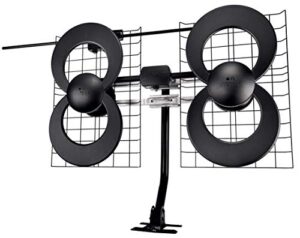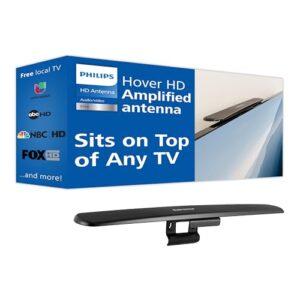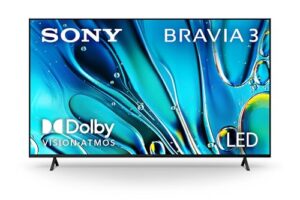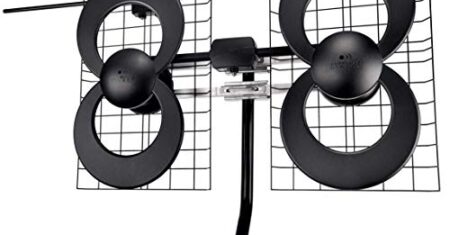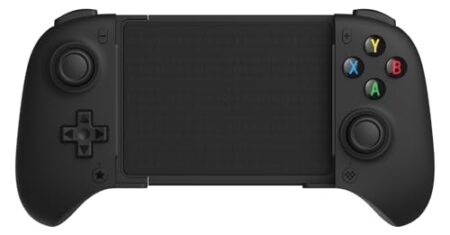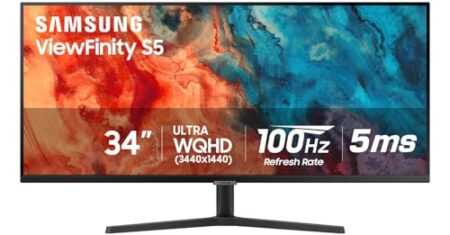Best Indoor Digital Antennas in 2025 (Top 8: Philips, Fronguld and More)
Tired of cable bills? Find the best indoor digital antennas to watch all your favorite local channels for free in stunning HD. Cut the cord and start saving!
Yes — you can watch live TV without a subscription. Over‑the‑air signals are still FREE and often surprisingly clear.
Contents
- The Best Indoor Digital Antennas
- Philips Hover Amplified TV Antenna
- HIDB Magnetic Base Indoor HDTV Antenna
- Oheotoo 2024 360° Reception Amplified Antenna
- Aquario 2025 Upgrade Amplified Indoor Antenna
- Qtbvae Long‑Range Indoor Amplified Antenna
- VGOSITE 400+ Mile Indoor/Outdoor Antenna
- Fronguld 2025 Long‑Range Amplified Antenna
- URIIU 2025 Indoor/Outdoor 999+ Mile Antenna
- Final Thoughts on the Best Indoor Digital Antennas
- How Does an Indoor Digital Antenna Work?
- Indoor vs. Outdoor Digital Antennas and Converters: What’s the Difference?
- How to Choose the Best Indoor Digital Antenna
- Check Out the Best Indoor Digital Antennas
- Also Check Out Other Helpful Articles
- Video About the Best Indoor Digital Antennas
The Best Indoor Digital Antennas








Philips Hover Amplified TV Antenna
You’ll get a refined, slim design that integrates with modern TVs and delivers reliable amplified reception. The TruAmp technology and Philips engineering make it a top pick for users who want brand reliability and consistent performance.
Pros
- Slim, TV‑top friendly design
- Integrated amplifier (TruAmp) for cleaner reception
- Supports VHF and UHF, 4K ready
- Easy mount options (top, wall, or tabletop)
Cons
- Slightly pricier than generic budget antennas
- May require power source for amplifier when used indoors
Design and who it's for
You’ll appreciate this antenna if you want a tidy, attractive unit that sits neatly on top of your flat screen. Philips designed this model to blend into your home theater while offering amplified performance that competes with larger indoor antennas.
Features, performance, and benefits
The integrated TruAmp amplifier and support for both VHF and UHF help you pull in a broad set of channels, and the 4K readiness means it will work with modern displays. Installation flexibility lets you mount it on the TV, place it on a shelf, or wall‑mount depending on your room layout.
- Slim footprint specifically made to sit on top of most modern TVs.
- TruAmp amplifier to boost weak signals and reduce noise.
- Multiple mounting options included for convenient setup.
Practical insights and limitations
You should see strong, consistent reception in many urban and suburban areas. If you live in a very remote area, an outdoor directional setup may still be necessary. Also, ensure you have a nearby USB or AC outlet for the amplifier if using the boost function indoors.
HIDB Magnetic Base Indoor HDTV Antenna
You’ll likely find it pulls in a surprising number of channels given its small size and omni‑directional design. It’s simple to install, discreet, and a very practical choice for apartments or rooms where an outdoor antenna isn’t feasible.
Pros
- Small, unobtrusive design with magnetic base
- Easy plug‑and‑play installation
- Long coax cable (10 ft) for flexible placement
- Good omni‑directional reception without precise aiming
Cons
- Not ideal for extreme fringe locations
- Build quality is basic compared with premium brands
Why you might choose this antenna
You’ll choose this antenna when you want a no‑fuss, compact indoor solution that doesn’t require aiming. The magnetic base makes it simple to attach to many metal surfaces, and the long cable gives you flexibility to position it for the best reception.
Notable features and everyday benefits
The antenna is omni‑directional so you don’t need to hunt for the exact bearing of broadcast towers, which is helpful when signals come from multiple directions. Many users report unexpectedly high channel counts at modest distances from towers.
- Magnetic base for secure mounting on metal surfaces.
- 10‑ft coaxial cable for flexible placement around the room.
- Compact footprint that’s easy to hide or tuck away.
Limitations and real‑world advice
While effective for most urban and suburban situations, you should not expect it to match an outdoor antenna if you live in a very fringe area. Try placement near windows, on higher shelves, or on metal TV mounts; one reviewer noted they get nearly 60 channels ~25 miles from a major city. If you need extreme range, plan for an outdoor directional antenna instead.
Oheotoo 2024 360° Reception Amplified Antenna
You’ll likely enjoy broad, stable reception thanks to the 360° design and strong amplifier. Installation is painless and the sleek look fits well in modern rooms, making it a great all‑around indoor pick.
Pros
- 360° reception for multi‑directional signal pickup
- Sleek modern design that blends into rooms
- Amplifier yields more channels and clearer pictures
- Positive user feedback for installation and reliability
Cons
- Priced higher than basic indoor antennas
- May be overkill if you already have strong local signals
Why opt for this 2024 release
You should consider this antenna if you want a modern indoor unit with multi‑directional reception and strong amplification. It’s built to pull in stations from several bearings without requiring you to constantly rotate or reorient the antenna.
Features and practical benefits
The 360° reception combined with a quality amplifier helps you capture channels that come from multiple tower directions, which is particularly useful in areas served by several transmitters. Users consistently note easy setup and improved channel counts after connecting the amplifier.
- 360° reception design reduces the need to orient the antenna.
- Amplified signal booster for better channel visibility.
- Stylish, low‑profile look suitable for living areas.
Notes on expectations and use
While the 360° design is helpful, you should still try a few locations — near a window or higher on the wall is often best. If you already receive strong OTA signals, the extra gain may not add much, but in mixed or challenging reception environments this model will typically deliver a noticeable improvement.
Aquario 2025 Upgrade Amplified Indoor Antenna
You’ll be able to pull in many local channels quickly and easily with this upgraded model, and the magnetic base and long cable make it flexible to position. It’s a great budget choice if you want broad channel coverage without complexity.
Pros
- Large user base with many positive reviews
- Strong magnetic base for flexible mounting
- Easy setup — plug in and scan
- Good channel pickup in many locations
Cons
- Marketing range figures can be optimistic
- Basic appearance and materials compared with premium models
Who should consider this antenna
You should consider this if you want a very affordable amplified indoor antenna that reliably pulls in local channels and has a proven track record with many users. The 2025 upgrade emphasizes stable reception and easy setup for everyday TV viewing.
What you’ll get and how it behaves
Expect quick channel scans and solid picture quality in many settings. The magnetic base and compact form let you try multiple mounting positions to find the sweet spot in your home.
- Magnetic mounting for metal surfaces and easy repositioning.
- Amplifier designed to work with modern TVs and 4K content.
- Simple installation: connect coax, power the amplifier if required, and run a channel scan.
Practical notes and limitations
This model works exceptionally well for most urban and suburban viewers but does not replace a proper outdoor directional antenna in very remote areas. For best results, try placing it near a window or elevated surface and experiment with the magnetic base to find the best orientation.
Qtbvae Long‑Range Indoor Amplified Antenna
You get a capable amplified indoor antenna that balances reception and affordability. It performs well for most suburban and urban installations and is a solid choice if you want 4K-ready free OTA channels without spending much.
Pros
- Affordable price for an amplified antenna
- Supports 4K and 1080p reception
- Inbuilt amplifier with IC chip to reduce interference
- Compact, easy to place
Cons
- Claims of 'long range' may be optimistic in fringe areas
- Quality of amplifier and build feels budget-tier
What this antenna does and who it's for
You can use this indoor amplified antenna to pick up free over‑the‑air local channels in 4K and 1080p without a monthly subscription. It’s designed for users who want a low‑cost, easy‑to‑install option and who live in urban or near‑suburban reception areas.
Key features and what you’ll notice
You’ll notice a small, unobtrusive form factor and a built‑in intelligent IC amplifier that aims to boost weak signals and reduce interference. Typical benefits include clearer local news, sports, and network programming without cable bills.
- Compact footprint that hides easily behind or on top of your TV.
- Intelligent IC chip and amplifier to enhance reception in many real‑world situations.
- 4K and 1080p compatible for modern TVs.
Practical considerations and limitations
You should expect solid performance when towers are within a reasonable distance (urban/suburban). If you are on the fringe (very far from transmitters or blocked by terrain/metallic structures), an outdoor or larger directional antenna will likely outperform this model. You may need to experiment with placement near windows or higher positions for best results.
VGOSITE 400+ Mile Indoor/Outdoor Antenna
You’ll like this if range is an important factor and you want the option to place the antenna outdoors. It delivers strong reception in many user reports and offers a long cable for flexible installation.
Pros
- Designed for long‑range reception (advertised 400+ miles)
- Long 18ft cable for flexible placement
- Works indoor or outdoor
- Clear picture quality reported by many users
Cons
- Actual effective range varies by geography
- Lighter build quality compared to premium outdoor antennas
Who this antenna suits
You should choose this model if you want the flexibility to try both indoor and outdoor installations and if you value a long cable run so you can place the antenna where the signal is strongest. Many users report immediate pickup of multiple HD channels after setup.
Key features and what to expect
The antenna advertises long‑range capability and includes a smart IC chip and amplifier to help with reception. The long cable is practical for placing the unit near windows, attic spaces, or an exterior wall without needing additional coax runs.
- Long 18ft cable for more placement options.
- Smart IC and amplifier to help with weaker signals.
- Supports modern resolutions including 4K and 8K claims.
Real‑world limitations and tips
You should treat the long‑range claims as best‑case scenarios; terrain, building construction, and tower distance will determine how many channels you actually get. If you live in a very isolated area, consider a purpose‑built outdoor directional antenna for consistent results. Try both indoor window placement and a sheltered outdoor mount to compare performance.
Fronguld 2025 Long‑Range Amplified Antenna
You’ll appreciate the upgraded smart IC and stronger amplifier when pulling in distant channels. It’s a good fit if you want a model that’s marketed for extended range while still keeping indoor convenience.
Pros
- Upgraded smart IC chip and amplifier
- Designed for long‑range reception
- Works as indoor or outdoor antenna
- Solid build with larger footprint for signal capture
Cons
- Higher price than simple indoor models
- Real‑world range depends heavily on local terrain and tower locations
- May require fine tuning of placement for optimal results
Overview and intended use
You can use this antenna indoors or outdoors when you want stronger reception for distant channels. The 2025 model emphasizes a newer IC chip and higher‑gain signal booster to try and deliver more stations farther away.
Features you'll benefit from
The design includes an amplified element and a more substantial antenna body than tiny stick antennas, which helps when you need extra pull on weaker signals. If you place it near a window or mount it outdoors, you’ll typically see the best results.
- Smart IC chip to improve signal handling and reduce some interference.
- Amplified design intended for long‑range reception.
- Indoor/outdoor flexibility so you can try both placements.
Practical tips and limitations
Expect that the claimed extreme ranges are marketing maxima; actual reception will vary by your distance from broadcast towers, terrain, and building materials. You should plan to try several locations and modes (indoor vs outdoor) and be prepared to return or replace if your environment is especially challenging.
URIIU 2025 Indoor/Outdoor 999+ Mile Antenna
You’ll get a very low‑cost option that still manages to pull in local HD channels for many users. It’s a practical budget choice if you want basic OTA reception or a backup antenna without spending much.
Pros
- Very low price point
- Supports indoor or outdoor mounting
- Includes long 16.5ft cable for flexible placement
- Good value for customers on a budget
Cons
- Marketing range claims likely exaggerated
- Power adapter uses older USB style on some units
- Build and materials feel budget‑oriented
Who should buy this antenna
You should pick this if you want an extremely affordable indoor/outdoor antenna to try free over‑the‑air TV without committing to a premium model. It’s a good backup option, dorm room solution, or first‑time antenna for cord‑cutters on a budget.
What it includes and how it performs
The antenna ships with a generous cable and supports both short and long range modes, letting you experiment with placement. Many users report easy setup and immediate channel discovery when placed near a window or mounted outdoors.
- 16.5ft cable for generous placement options.
- Two reception modes (short and long) to suit different tower proximities.
- Compact, unobtrusive look that’s easy to hide.
Practical advice and caveats
You should temper expectations about the dramatic '999+ mile' range claims; those are best‑case marketing figures. Real performance depends on towers, terrain, and surrounding structures. If you need consistently high channel counts in a remote area, consider moving up to a dedicated outdoor directional antenna; otherwise, this model offers a remarkably low‑cost way to start watching free OTA channels.
Final Thoughts on the Best Indoor Digital Antennas
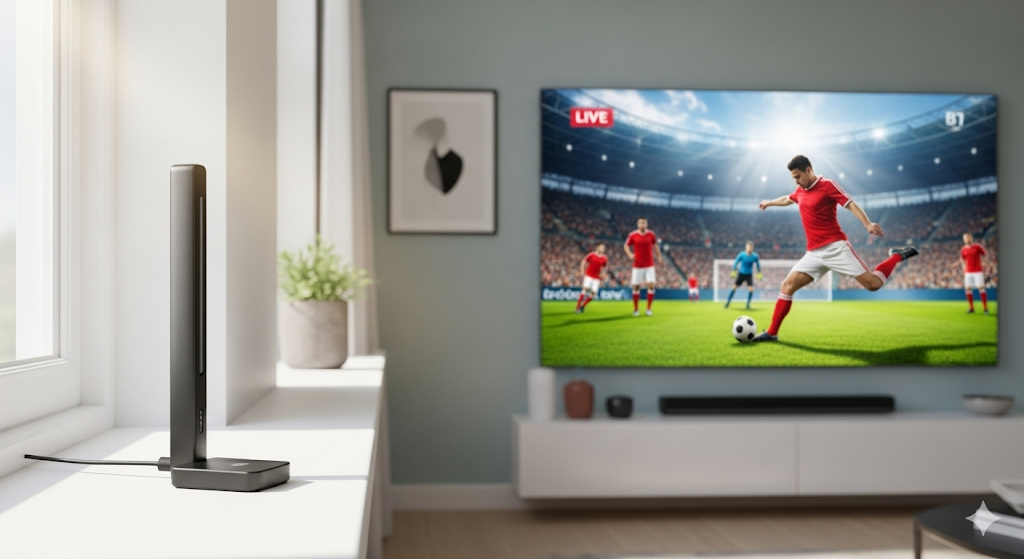
Pick the Philips Hover Amplified TV Antenna if you want the easiest path to reliable, high‑quality reception in a living room or main TV. Its slim, TV‑top design and TruAmp amplification give you consistent channels with minimal fiddling. Ideal for modern homes where you want a neat install and steady performance.
Choose the HIDB Magnetic Base Indoor HDTV Antenna if you live in an apartment, have a secondary TV, or need a discreet, low‑cost solution. It’s compact, omni‑directional, and surprisingly capable. Place it near a window or on a higher shelf and you’ll likely pick up many local channels without any rooftop gear.
How Does an Indoor Digital Antenna Work?
An indoor digital antenna captures over-the-air broadcast signals from local TV stations and transmits them to your television or digital converter. It converts electromagnetic waves into electrical signals, allowing you to watch high-definition digital channels without the need for cable or satellite services.
Compact and easy to install, this type of antenna is perfect for apartments or houses close to broadcast towers. For best performance, place the antenna near windows and away from obstacles that could interfere with the signal.
Indoor vs. Outdoor Digital Antennas and Converters: What’s the Difference?
Indoor digital antennas are compact and ideal for urban areas where the broadcast signal is usually strong. They can be placed on shelves or mounted near windows for convenience.
Outdoor antennas, on the other hand, are larger and designed for rural or suburban areas where signals are weaker and require greater range. While they provide stronger reception, their installation is more complex and typically requires higher placement, such as rooftops.
A digital converter works differently—it doesn’t capture signals but processes them. It transforms the signal received by the antenna into picture and sound for your TV. Older television models often need a converter, while most modern TVs already have one built in.
How to Choose the Best Indoor Digital Antenna
Selecting the best indoor digital antenna depends on your location and the strength of the broadcast signals in your area. Here are the key factors to consider:
1. Signal Reception: Match the Antenna to Your Local Conditions
- Strong Signal Areas: Antennas with 5–7 dBi gain are often sufficient, though models with 7 dBi or higher provide more stable reception.
- Weak Signal Areas: Choose wall-mounted amplified antennas with 10 dBi or more. Amplifiers can significantly boost signal quality and unlock access to additional channels.
When choosing placement, a wall-mounted design is ideal because it allows positioning the antenna higher up, minimizing obstructions. For easier installation in rentals, adhesive wall mounts are a good alternative to drilling.
2. Prefer an Omnidirectional Antenna for Stable Reception
Omnidirectional antennas receive signals from all directions (360°), making them more reliable in dense urban areas. Unlike directional or bidirectional antennas, they don’t need precise alignment, which makes installation easier and ensures consistent reception even if the TV is moved.
3. Look for Full HD Compatibility
Most free-to-air broadcasts today are available in Full HD resolution. Choosing an antenna that supports Full HD ensures you’ll enjoy maximum picture quality. Some models are also labeled as 4K-ready, which could be useful as broadcasting standards evolve.
4. Check for VHF Support in Rural Areas
Although digital TV primarily uses UHF, some local stations—especially in smaller towns—still broadcast on VHF. If you want access to local news and content, choose an indoor digital antenna that supports both UHF and VHF. Some models even include FM support for radio listening.
5. Use Cables No Longer Than 2 Meters
Many antennas include a coaxial cable, but lengths vary. While longer cables don’t directly affect signal reception, excess length can cause bending, oxidation, or damage over time. To preserve image quality and the antenna’s lifespan, a maximum length of 2 meters is recommended.
By considering these factors—signal strength, design, reception type, compatibility, and cable length—you’ll be able to choose the best indoor digital antenna for your home and enjoy stable, high-quality free-to-air television.
Check Out the Best Indoor Digital Antennas
Still not sure which one to choose? Click the link below to see the best-selling products.
Also Check Out Other Helpful Articles
Take a look at more useful articles that can help you make more informed decisions.
- Best Outdoor Digital Antennas in 2025 (Top 9: PBD, ClearStream and More)
- Best Indoor Digital Antennas in 2025 (Top 8: Philips, Fronguld and More)
- Best 55-Inch TVs in 2025 (Top 7: TCL, Sony Bravia and More)
Video About the Best Indoor Digital Antennas
We created a video on the topic. Just click to watch.
About the Author
